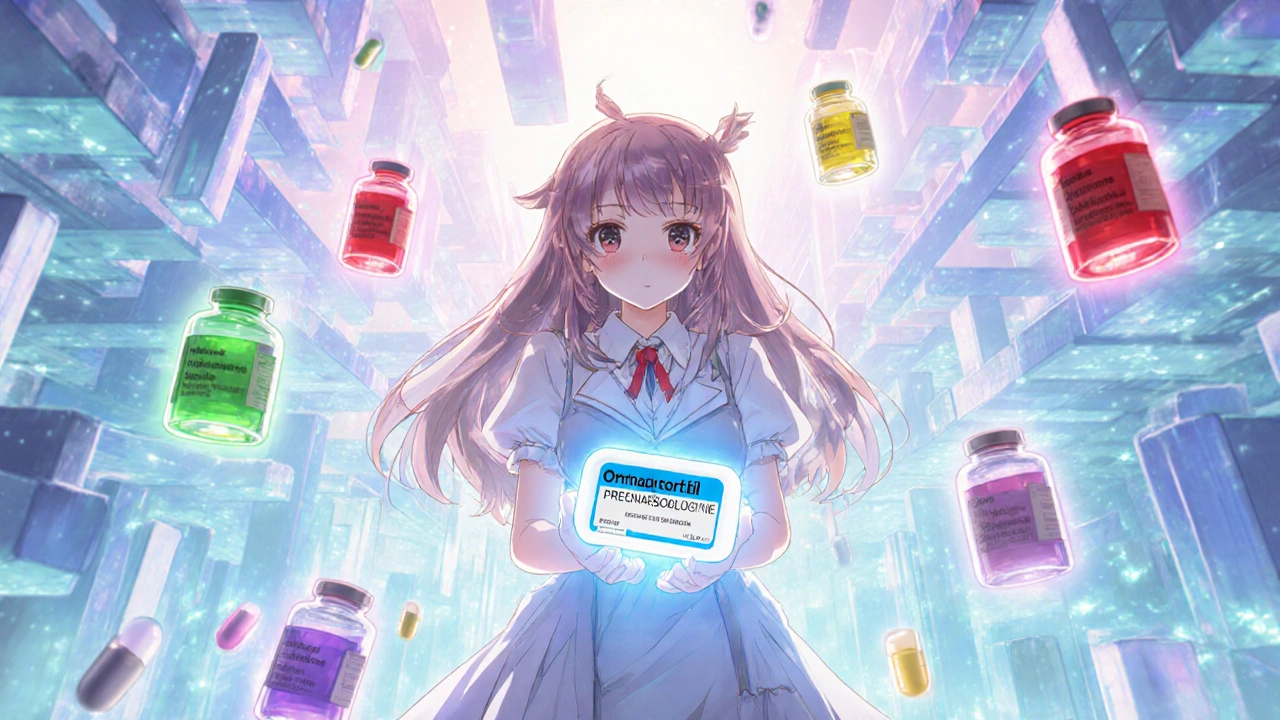 Oct, 20 2025
Oct, 20 2025
Corticosteroid Dose Conversion Calculator
Convert doses between different corticosteroids based on their relative potencies. Enter the dose of the source steroid to calculate the equivalent dose of the target steroid.
Equivalent Dose: mg of
When you pick a corticosteroid, the choice can feel like a maze of names, dosages, and side‑effect profiles. Omnacortil (Prednisolone) is a synthetic glucocorticoid widely prescribed for inflammatory and autoimmune conditions. It works by mimicking cortisol, the hormone your adrenal glands release during stress. If you’re wondering how it stacks up against other steroids, you’ve come to the right spot.
Key Takeaways
- Omnacortil is a mid‑potency oral glucocorticoid with a half‑life of about 2‑3 hours.
- Alternative steroids differ mainly in potency, duration of action, and preferred clinical uses.
- When choosing, balance disease severity, required speed of symptom control, and side‑effect tolerance.
- Common alternatives include Prednisone, Hydrocortisone, Methylprednisolone, and Dexamethasone.
- Switching steroids should be done under medical supervision to avoid adrenal suppression.
What Makes Omnacortil (Prednisolone) Tick?
Omnacortil belongs to the prednisolone family, which is about 4‑5 times more potent than natural cortisol. It is usually taken orally, making it convenient for chronic conditions such as asthma, rheumatoid arthritis, and ulcerative colitis. The drug reaches peak plasma levels within an hour, and its anti‑inflammatory effect can be felt within a day for acute flare‑ups.
Key attributes:
- Potency: Medium‑high - roughly 4× cortisol.
- Onset: 30‑60 minutes.
- Half‑life: 2‑3 hours (biological effects last longer due to gene transcription).
- Typical dose: 5‑60 mg per day, adjusted to disease severity.
Because it is a synthetic analogue, the body cannot convert it back to a less active form, so the risk of long‑term side effects-like osteoporosis or glucose intolerance-grows with duration.
Why Look at Alternatives?
Not every patient tolerates prednisolone well. Some need a faster‑acting steroid for emergencies, while others benefit from a milder agent for long‑term maintenance. The main reasons to consider alternatives are:
- Potency mismatches: Too strong a steroid can cause excess weight gain, mood swings, or hypertension.
- Duration of action: Short‑acting steroids are better for intermittent dosing; long‑acting ones reduce pill burden.
- Route of administration: Topical, injectable, or inhaled forms bypass first‑pass metabolism.
- Specific disease guidelines: Some societies recommend certain steroids for particular conditions.
Head‑to‑Head Comparison Table
| Attribute | Omnacortil (Prednisolone) | Prednisone | Hydrocortisone | Methylprednisolone | Dexamethasone |
|---|---|---|---|---|---|
| Potency (relative to cortisol) | 4‑5× | 4‑5× (pro‑drug, converts to prednisolone) | 1× (identical to cortisol) | 5‑6× | 25‑30× |
| Half‑life (hours) | 2‑3 | 2‑4 | 1‑2 | 3‑4 | 36‑54 |
| Typical oral dose | 5‑60 mg | 5‑60 mg | 20‑240 mg | 4‑48 mg | 0.5‑9 mg |
| Common uses | Asthma, RA, IBD | Similar to prednisolone, often used in US | Adrenal insufficiency, topical swaps | Severe flare‑ups, IV therapy | Brain edema, chemotherapy adjunct |
| Route flexibility | Oral, IV (as sodium succinate) | Oral, IV | Oral, IV, topical | IV, IM, oral | IV, oral, eye drops |

When to Stick with Omnacortil
If you need a reliable, mid‑potency oral steroid that works quickly and has a well‑understood side‑effect profile, prednisolone remains a first‑line choice. Its dosing flexibility (once‑daily or split) fits busy lives, and most clinicians are comfortable adjusting it based on blood tests for glucose or bone density.
Scenarios that favour Omnacortil:
- Chronic autoimmune diseases where gradual tapering is planned.
- Patients who cannot tolerate the higher potency of dexamethasone.
- When an oral tablet is the only feasible route (e.g., outpatient setting).
When an Alternative Might Be Better
Each steroid has a niche. Below are quick pointers for when to consider swapping.
| Hydrocortisone | Best for physiologic replacement in adrenal insufficiency-its low potency mirrors natural cortisol. |
| Prednisone | Identical to prednisolone after liver conversion; useful when liver function is normal and cost is a concern (often cheaper in the US). |
| Methylprednisolone | Higher potency and longer duration; ideal for severe flares needing IV infusion (e.g., lupus nephritis). |
| Dexamethasone | Very high potency and an ultra‑long half‑life; reserved for life‑threatening inflammation, brain tumors, or chemotherapy protocols. |
Practical Tips for Switching
Never hop from one steroid to another without a taper plan. Here’s a safe approach:
- Calculate the equivalent dose using potency ratios (e.g., 5 mg dexamethasone ≈ 125 mg prednisolone).
- Start the new steroid at the equivalent dose for 1‑2 days.
- Gradually taper the original drug over 3‑5 days while monitoring symptoms.
- Check blood glucose, blood pressure, and bone markers after the switch.
- Schedule a follow‑up visit within two weeks to assess adrenal suppression.
Remember, abrupt cessation can trigger adrenal crisis-a medical emergency.

Side‑Effect Profile at a Glance
All corticosteroids share a core set of adverse effects, but the intensity varies with dose and duration.
- Weight gain & fluid retention: More pronounced with higher potency (e.g., dexamethasone).
- Blood sugar spikes: Common across the board; monitor if you have diabetes.
- Bone loss: Long‑term use (>3 months) warrants calcium, vitamin D, or bisphosphonate therapy.
- Mood changes: Prednisolone and methylprednisolone can cause irritability or euphoria.
- Infection risk: Immunosuppression rises with cumulative dose; vaccinate before starting if possible.
Bottom Line: Personalise the Choice
There is no one‑size‑fits‑all steroid. The decision hinges on the disease, how fast you need relief, how you plan to taper, and your personal tolerance for side effects. Talk with your doctor about the pros and cons of each option, and keep an eye on lab results while you’re on therapy.
Frequently Asked Questions
Can I take Omnacortil and Prednisone together?
Generally no. Both convert to the same active molecule, so using them together just adds dose without extra benefit and raises side‑effect risk. If a doctor needs a higher total glucocorticoid effect, they’ll usually choose a single, higher‑dose steroid rather than stacking.
How do I know which steroid is right for my asthma?
Mild‑to‑moderate asthma is often controlled with low‑dose prednisolone or inhaled corticosteroids. For an acute severe attack, a short burst of higher‑potency methylprednisolone (IV) may be prescribed. Your pulmonologist will base the choice on severity, frequency of attacks, and your response to past steroids.
What is the equivalent dose of dexamethasone to 10 mg of prednisolone?
Dexamethasone is about 25‑30 times more potent. Roughly, 0.5 mg of dexamethasone equals 10 mg of prednisolone. Always have a clinician confirm the conversion before changing medication.
Are there natural ways to reduce reliance on steroids?
Lifestyle tweaks-like a balanced diet, regular low‑impact exercise, stress‑management techniques, and adequate sleep-can lower baseline inflammation. However, they complement but rarely replace prescription steroids for moderate‑to‑severe autoimmune or inflammatory disease.
How long should I stay on Omnacortil before tapering?
If you start with a short course (≤2 weeks), you can often stop abruptly under doctor guidance. For longer courses, tapering over weeks to months is standard to allow the adrenal glands to resume normal cortisol production.
Deja Scott
October 20, 2025 AT 19:15Omnacortil offers a solid middle ground-enough potency to control flare‑ups without the extreme side‑effects you see with dexamethasone. Its oral dosing makes it practical for daily life, and the half‑life is short enough to titrate quickly. Many patients find the taper schedule manageable when the doctor monitors glucose and bone health.
Demetri Huyler
October 21, 2025 AT 17:28Look, if you’re hunting for the “biggest bang” you’re better off with dexamethasone, but for most folks Omnacortil hits the sweet spot. It’s not just a U.S.‑centric fad, the pharmacology backs it up.
JessicaAnn Sutton
October 22, 2025 AT 15:41Prednisolone, marketed as Omnacortil, is chemically identical to the active metabolite of prednisone, ensuring predictable bioavailability. Its dose‑response curve is well documented across rheumatologic and gastroenterologic indications. The risk profile, while non‑trivial, remains less severe than that of high‑potency agents such as dexamethasone. Consequently, clinical guidelines frequently recommend it as a first‑line oral glucocorticoid.
Israel Emory
October 23, 2025 AT 13:55Indeed, the literature supports that view, and when you consider the pharmacokinetics-rapid absorption, peak plasma within an hour, and a biological half‑life extending beyond the serum value-the flexibility for tapering becomes evident, especially for chronic autoimmune conditions, where balancing efficacy and side‑effects is paramount.
Wesley Humble
October 24, 2025 AT 12:08From a mechanistic standpoint, prednisolone exerts its anti‑inflammatory effects via transrepression of NF‑κB pathways, thereby reducing cytokine production. 📊 Moreover, the conversion of prednisone to prednisolone in hepatic tissue underscores the importance of liver function in dosing considerations; patients with hepatic impairment may require dose adjustments. 📈 Lastly, vigilant monitoring of bone mineral density is advisable when therapy exceeds three months, as glucocorticoid‑induced osteoporosis is a well‑established risk.
barnabas jacob
October 25, 2025 AT 10:21Yo, the liver thing is real, but dont forget u gotta watch ur sugar levels too, especially if u got diabetes. Also, dont overdo the dose, ur gonna feel the side effects fast.
jessie cole
October 26, 2025 AT 07:35Think of Omnacortil as the reliable teammate you can count on during a marathon. It delivers steady anti‑inflammatory power without the roller‑coaster spikes of ultra‑potent steroids. With proper monitoring, it helps you stay in the game for the long haul.
Kirsten Youtsey
October 27, 2025 AT 05:48While the analogy is appealing, one must acknowledge that the pharmaceutical industry subtly steers prescribers toward newer, more profitable compounds, often under the guise of “advanced therapy.” This bias can cloud objective assessment of tried‑and‑true agents like prednisolone.
Matthew Hall
October 28, 2025 AT 04:01Honestly, the whole steroid debate feels like a soap‑opera drama on repeat.
laura wood
October 29, 2025 AT 02:15I hear you; the constant back‑and‑forth can be exhausting. What helps me is focusing on the concrete data-half‑life, potency, and patient‑specific factors-rather than getting swept up in sensational headlines.
Kate McKay
October 30, 2025 AT 00:28When deciding between prednisolone and its alternatives, start by listing your clinical priorities: rapid symptom control, minimal side‑effects, or dosing convenience. If rapid control is paramount, a short‑acting agent like hydrocortisone may suffice; for chronic management, prednisolone’s balance often wins. Always involve your healthcare provider in tailoring the taper schedule to your personal health profile.
Sebastian Green
October 30, 2025 AT 22:41Good point-personalized tapering makes all the difference.
Vijaypal Yadav
October 31, 2025 AT 20:55In the Indian context, cost considerations often favor prednisolone over brand‑name equivalents, as generic formulations are widely available and affordable. Additionally, many patients have co‑existing hepatic conditions due to viral hepatitis, making the conversion of prednisone to prednisolone a pertinent factor; direct prednisolone avoids reliance on hepatic activation. Nonetheless, clinicians should remain vigilant for adrenal suppression, especially when transitioning between agents with vastly different potencies.
Ron Lanham
November 1, 2025 AT 19:08It is incumbent upon both prescribers and patients to recognize that glucocorticoid therapy is not a monolithic intervention but a spectrum of pharmacologic actions that must be matched to individual disease phenotypes. First, the potency of the steroid dictates the intensity of immunosuppression; prednisolone, sitting at roughly four to five times the activity of endogenous cortisol, offers a moderate suppression that is sufficient for many autoimmune flares without the extreme catabolic consequences seen with dexamethasone. Second, the half‑life influences dosing frequency; a drug with a two‑hour half‑life allows for once‑daily dosing with minimal peaks, thereby reducing the risk of hypothalamic‑pituitary‑adrenal axis disruption. Third, the route of administration matters; oral prednisolone bypasses first‑pass metabolism yet remains subject to gastrointestinal absorption variability, whereas intravenous formulations guarantee bioavailability in acute settings. Fourth, patient comorbidities such as diabetes, osteoporosis, or hypertension must inform the choice, as higher‑potency steroids exacerbate glucose intolerance and bone demineralization. Fifth, the economic burden cannot be overlooked; generic prednisolone is often the most cost‑effective option, ensuring adherence in resource‑limited environments. Sixth, the transition between steroids necessitates careful equivalence calculations; a naïve switch from prednisolone to methylprednisolone without dose adjustment can inadvertently increase glucocorticoid exposure by 20 percent. Seventh, monitoring protocols-including periodic fasting glucose, blood pressure, and DEXA scans-should be instituted early in the treatment course to preempt long‑term complications. Eighth, patient education about the signs of adrenal insufficiency, such as fatigue, nausea, and hypotension, is essential, particularly during tapering phases. Ninth, clinicians should remain aware of drug‑drug interactions; enzymes like CYP3A4 can alter steroid metabolism, affecting both efficacy and toxicity. Tenth, the psychological impact of chronic steroid use, ranging from mood swings to cognitive changes, warrants a multidisciplinary approach involving mental health professionals. Eleventh, recent guidelines suggest employing the lowest effective dose for the shortest duration feasible, a principle that underscores the importance of individualized tapering schedules. Twelfth, in cases where rapid anti‑inflammatory action is required, such as severe asthma exacerbations, a short course of high‑potency steroids may be justified before transitioning back to prednisolone for maintenance. Thirteenth, the decision matrix should also incorporate patient preference, as adherence improves when patients feel involved in their treatment plan. Finally, ongoing research into selective glucocorticoid receptor modulators holds promise for future therapies that retain anti‑inflammatory benefits while minimizing systemic side‑effects, potentially reshaping the current paradigm of steroid selection.